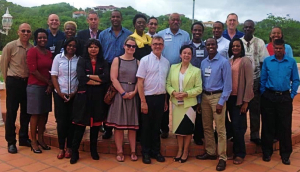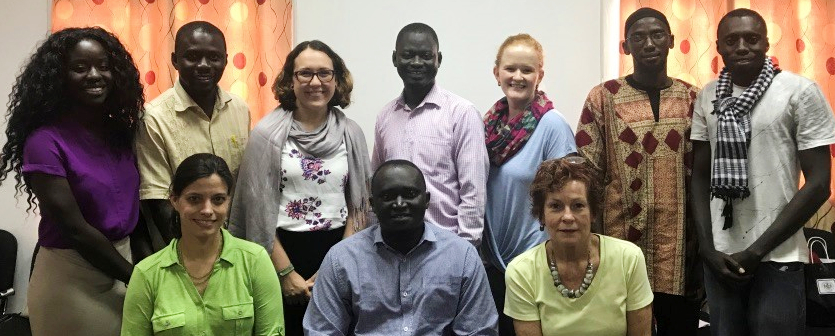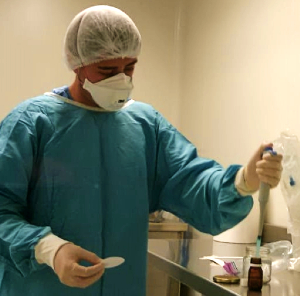 In 2009, the Division of Occupational and Environmental Medicine was named a Pan American Health Organization, World Health Organization (PAHO/WHO) Collaborating Center for Occupational Health.
In 2009, the Division of Occupational and Environmental Medicine was named a Pan American Health Organization, World Health Organization (PAHO/WHO) Collaborating Center for Occupational Health.
Our staff provides technical expertise and content knowledge in support of the WHO Global Plan of Action on Workers' Health – with an emphasis on the healthcare sector.
Currently, our work includes enhancing capacity among PAHO employees who are themselves health workers, regarding their own safety and health, and sustaining their advances through safety and health committee functions and responsibilities.
We are also assisting in providing toxicology and infection control training in collaboration with PAHO partners and WHO Collaborating Centers in occupational health in the Caribbean and the Americas. This activity also includes a provision of technical training and assistance in occupational and environmental cancer control and prevention.
We have worked beyond the PAHO region since 2014, through a University of Maryland, Baltimore, School of Medicine collaboration with the Gambian Ministry of Health.
Major Activities
Health Workforce Protection
As described, our UMB CC’s major area of activity is in the health sector. Below, we describe particular lines of work:
Health System Strengthening
Collaborations
Responding to public health needs in the PAHO region, our team has applied its occupational health expertise to assist regional partners in response to pandemics (H1N1, Guyana, 2009); long-standing threats to health workers, such as tuberculosis in pathology workers (Belize, 2011); and by providing capacity-building in training settings (Trinidad and Tobago, 2009). Other occasions to offer virtual assistance have been provided, for example, on health worker safety policies and sanitation programs (Jamaica, 2010). More recent on-site trainings in the PAHO region on occupational cancer prevention (Grenada and Chile, 2018) are described below.
Since 2014, the University of Maryland, Baltimore, School of Medicine began an ongoing collaboration with the Gambian Ministry of Health, the University of the Gambia School of Medicine, and Allied Health Science to strengthen the Gambian health system by building local capacity to protect health workers from workplace hazards. With our Division of Occupational and Environmental Medicine as the lead, we performed initial facility safety visits and developed several tools (available below) to help assess occupational health and safety practices within the health sector.

Occupational Health and Safety
- Occupational Health and Safety Dashboard
- Mental Health and Wellness (PowerPoint)
- Ergonomics and Stress (PowerPoint)
Due to the Ebola outbreak in Gambia’s neighboring countries and our CC’s expertise in health worker protection, our team was also requested to assist the WHO Geneva Office of Worker Health in preparing safety documents and deployed one of our team members there for several months.
Hepatitis B Program
Since 2018, the Division of Occupational and Environmental Medicine has provided consultation to the University of Maryland’s Center for Vaccine Development in Bamako, Mali, on implementation of a Hepatitis B screening and vaccination program for health worker study staff. To better understand the occupational risks for these workers and to identify opportunities for intervention, a questionnaire about the prevalence and work practices regarding Hepatitis B was developed.
Prevention of Occupational Cancer
Given the history of mining in many countries of the PAHO region, and exposure to lung carcinogens such as silica, asbestos, and toxic metals, occupational cancer prevention efforts have been a significant focus for our team with experience in pulmonary medicine and carcinogen prevention.
In August 2019, PAHO Collaborating Centers for Occupation Health met in Washington, D.C. During meetings focused on strategies to eliminate silica-related disease and assessing the burden of occupational cancers in the Americas, an emerging body of literature focused on the utility of lung cancer screening using low-dose chest CT (LDCT) in occupationally-exposed cohorts was discussed.

Other cancer prevention work has involved providing exposure assessment tools and participating in the CAREX (Carcinogen Exposure) effort in the Americas. Our team has participated in capacity building from 2009 (Bogota) through 2018 (Grenada and Santiago, Chile) related to the CAREX program and promoting exposure prevention.
- PAHO Lung Cancer Screening
(A Basis for Consideration for Implementation in the Americas)
 A third line of work in occupational cancer prevention promotes the safe handling of hazardous anti-cancer drugs. Many of these drugs are themselves carcinogenic. Initial capacity-building efforts toward safe handling of these agents include an instructional PAHO monograph and a subsequent companion training slide set, completed in Spanish in 2019.
A third line of work in occupational cancer prevention promotes the safe handling of hazardous anti-cancer drugs. Many of these drugs are themselves carcinogenic. Initial capacity-building efforts toward safe handling of these agents include an instructional PAHO monograph and a subsequent companion training slide set, completed in Spanish in 2019.
- Safe Handling of Hazardous Drugs (Spanish) (PowerPoint)
- Validacion Tecnica Analitica
- Accessible analytical methodology for assessing workplace contamination of antineoplastic drugs in limited-resource oncology healthcare settings
- Measuring extent of surface contamination produced by the handling of antineoplastic drugs in low- to middle-income country oncology health care settings
COVID-19 Prevention and Response in the Health Workforce
Possessing deep expertise in health worker occupational health, epidemiology and respiratory protection, our team has been represented at ongoing EPI WIN and other WHO virtual meetings on COVID-19 in health workers and has contributed various tools and work products for shared use. See links below.
- Resources for Coping with Stress (template for adaptation to local conditions and resources)
- COVID-19 Employee Tracking System
Elastomeric Respirator Implementation Guide
The link below will bring you to a University of Maryland website which describes how to implement an elastomeric respirator program and includes a number of other links.
Articles Addressing Worker Health
- COVID-19 and Essential Workers: A Narrative Review of Health Outcomes and Moral Injury
Gaitens, J.; Condon, M.; Fernandes, E.; McDiarmid, M. Int. J. Environ. Res. Public Health, 2021, 18(4), 1446 - The Healthcare Sector Employer’s Duty of Care: Implications for Worker Well-Being
McDiarmid, M.; Condon, M.; Gaitens, J. Int. J. Environ. Res. Public Health, 2021, 18 (11), 6015
